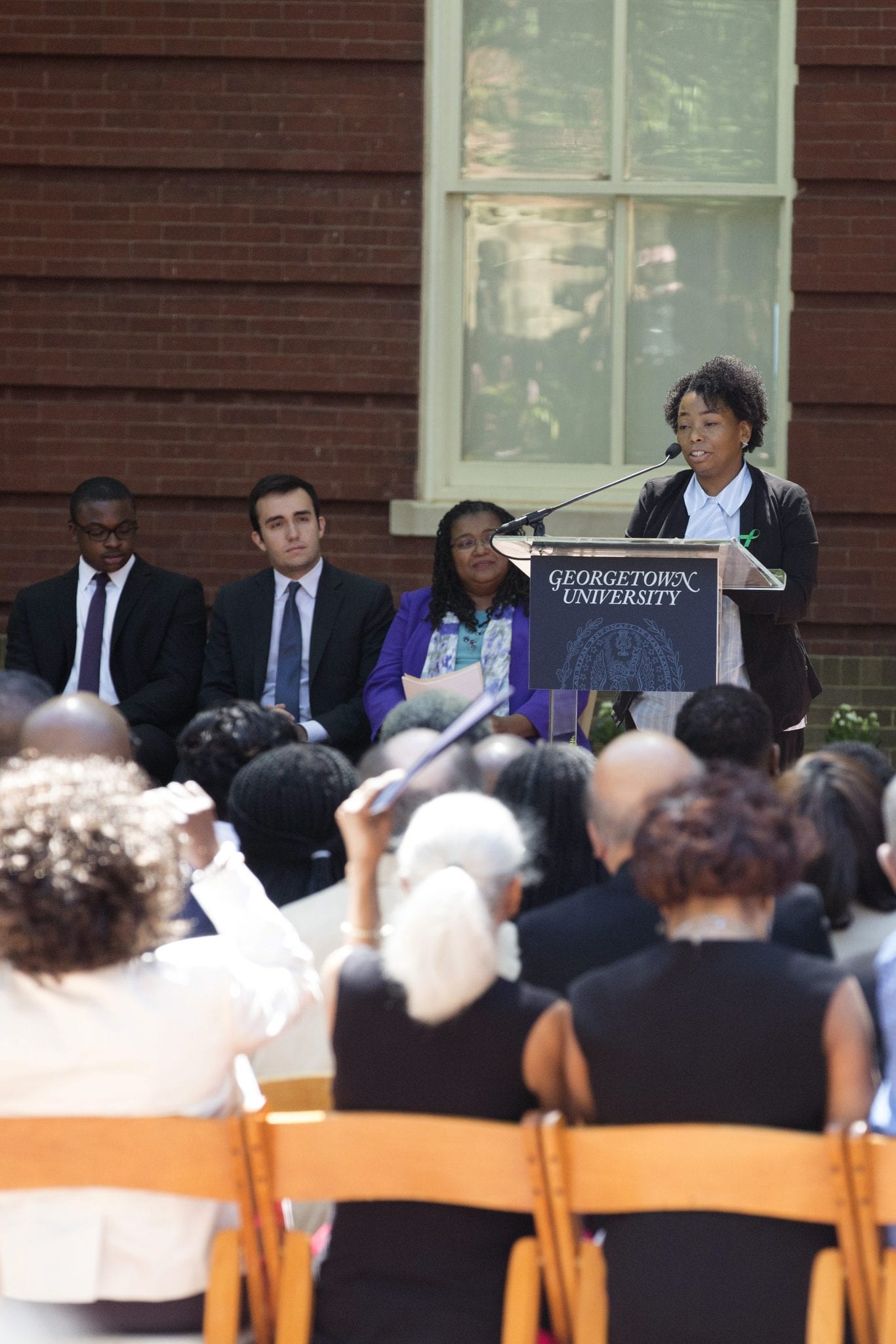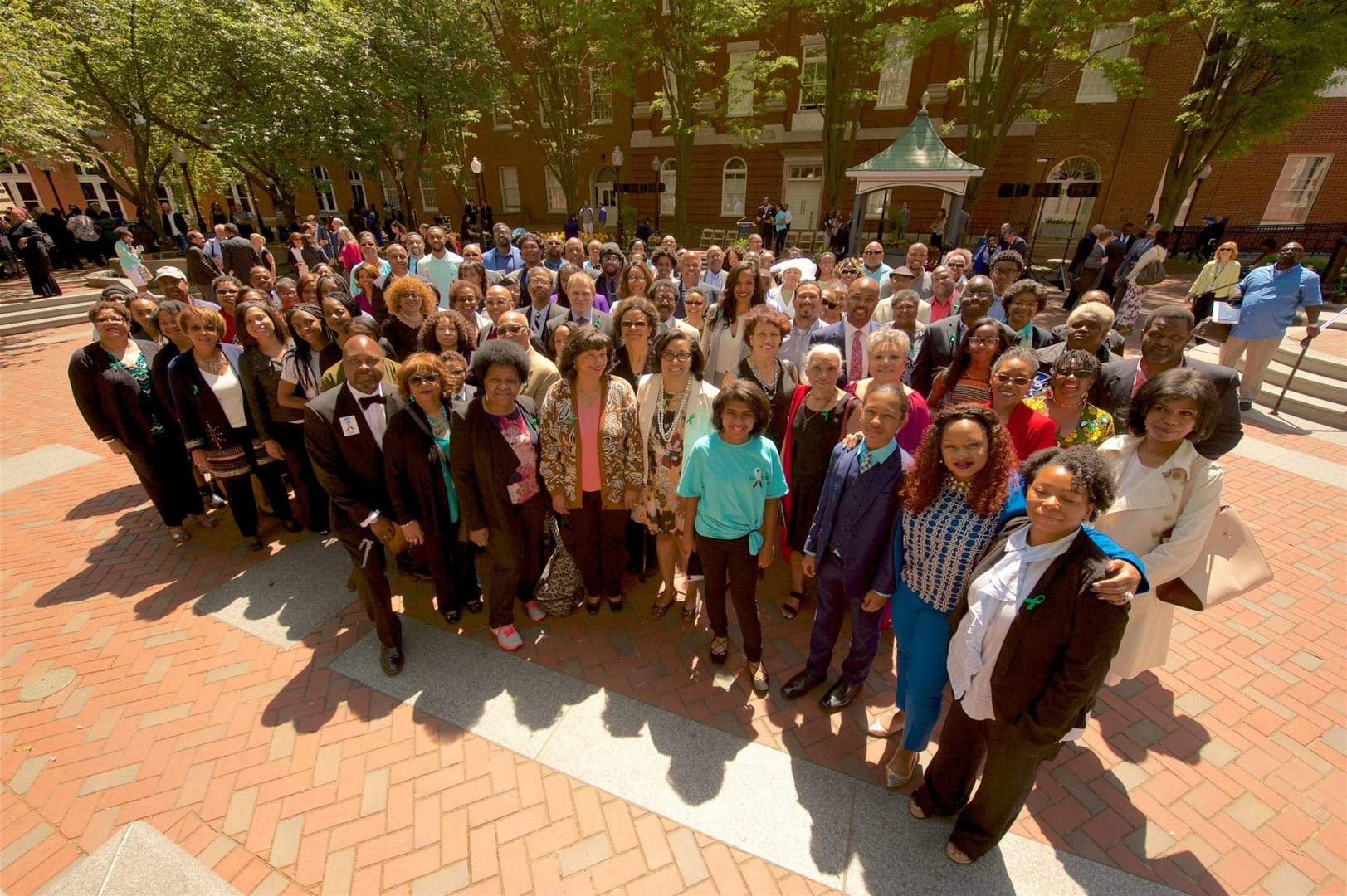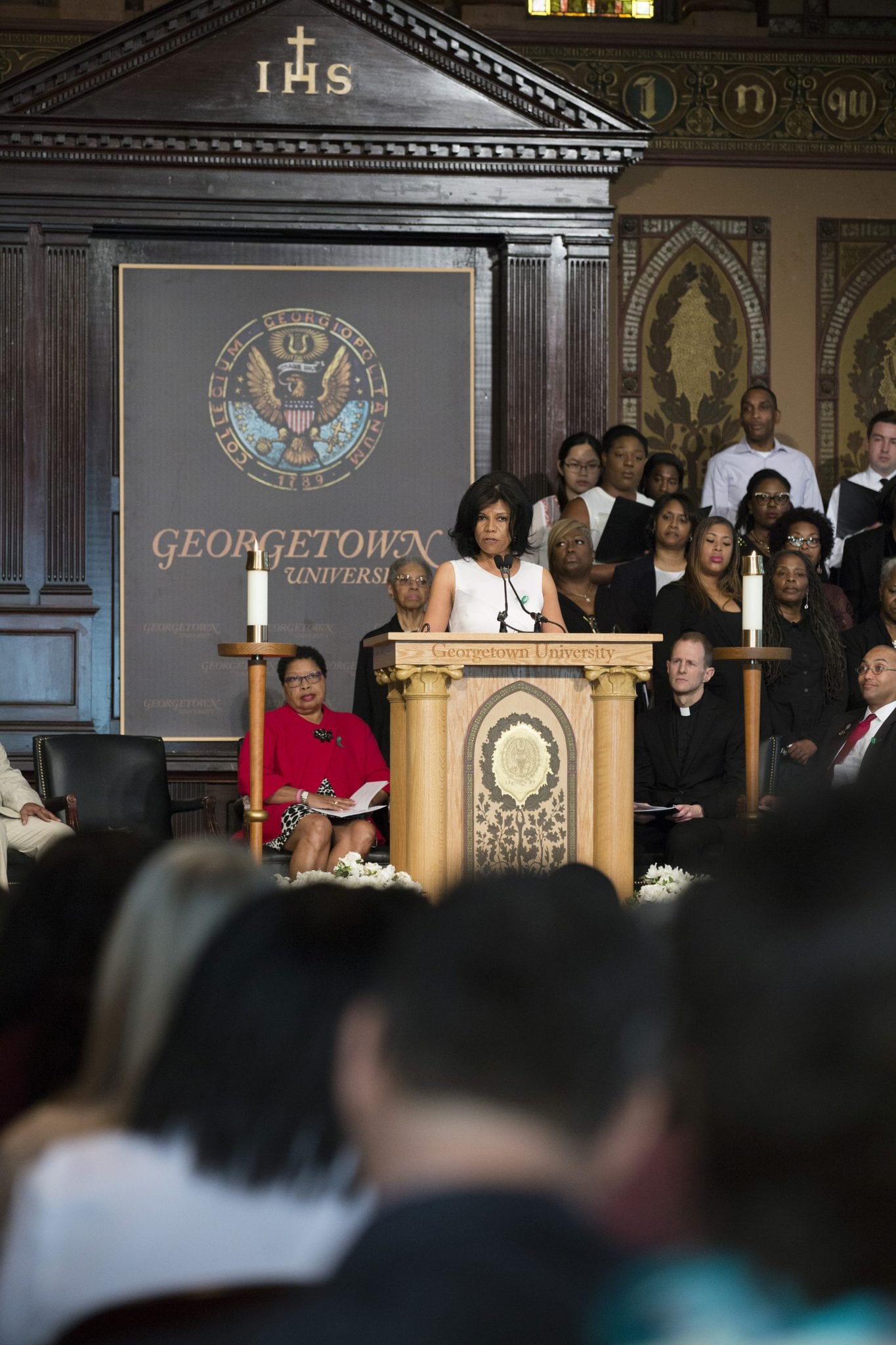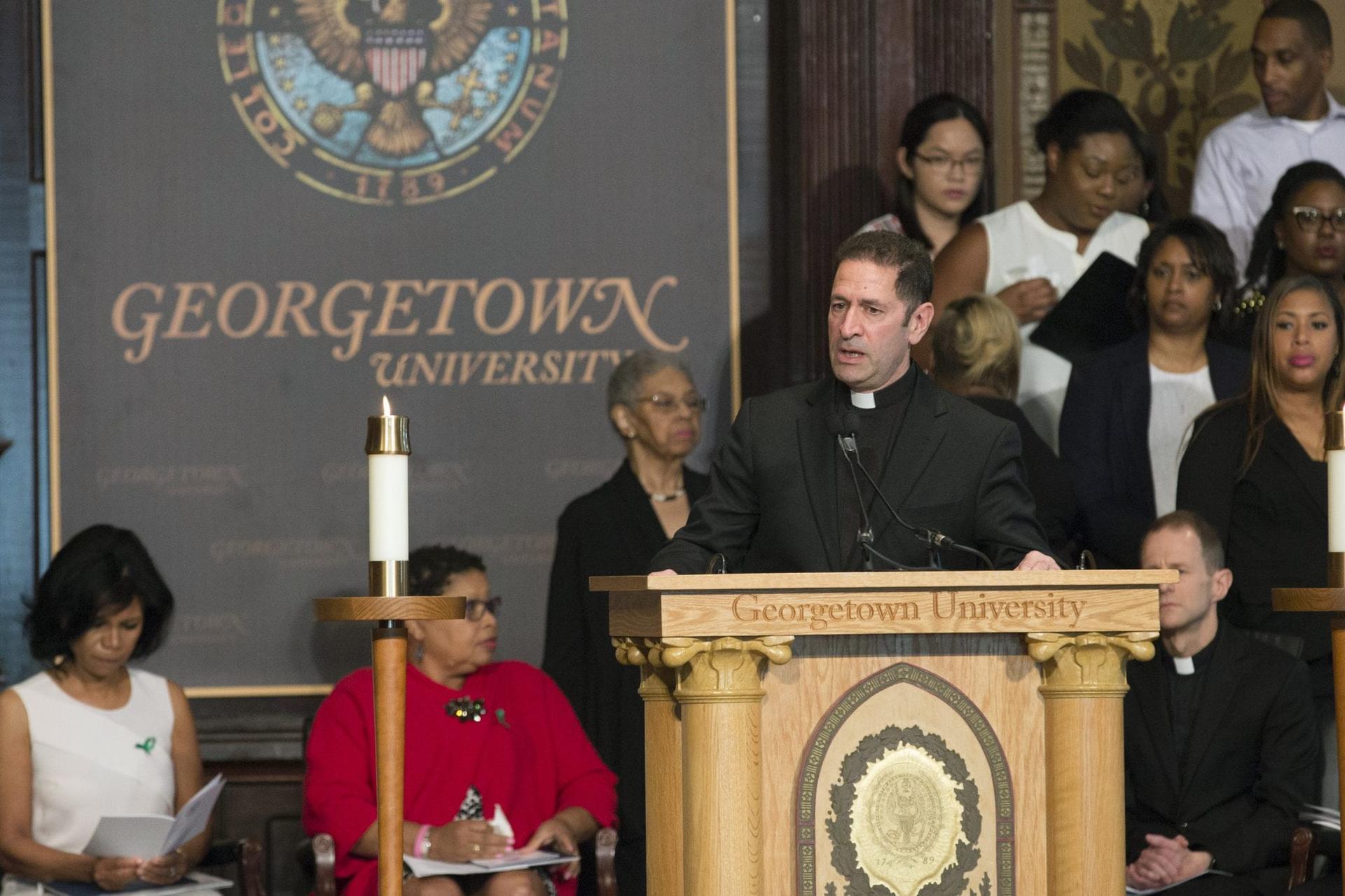WASHINGTON, D.C. — On a day when Georgetown University officials expressed public contrition over its legacy of slavery and a resolve to work together for a better world, Jessica Tilson as a descendant of slaves sold by the university’s leaders in the 1800s embodied both those emotions of sorrow and hope.
Addressing the crowd gathered on April 18 in the quadrangle in front of the university’s Dahlgren Chapel, Tilson – a 35-year-old microbiology student at Southern University in Baton Rouge, Louisiana – stood before a building newly renamed Isaac Hawkins Hall, in honor of her ancestor.
Isaac Hawkins was a 65-year-old slave who was sold in 1838 along with 271 other enslaved women, children, and men by the Maryland Province of Jesuits to benefit Georgetown University, which was then facing financial difficulty.
The building had been formerly named for Jesuit Father Thomas Mulledy, who as head of the U.S. Jesuits had brokered the sale of the slaves. The first name listed on the bill of sale to two plantation owners in Louisiana was of a man named Isaac, whom researchers discovered was Hawkins.
Georgetown history professor Maurice Jackson – part of the university’s working group of faculty, students, alumni, staff, and Jesuit priests studying its slavery history and a path for reconciliation – said renaming the building for Hawkins, who would represent the other enslaved people sold to benefit the university, demonstrated that they were “real people with real names” who should be remembered.

The dedication ceremony also included the renaming of another building – the oldest on campus – as Anne Marie Becraft Hall, in honor of a free woman of color and pioneer educator who in 1820 founded a school in Georgetown’s neighborhood to teach African American girls. She later joined the Oblate Sisters of Providence, an historic order of African-American women religious. That Georgetown building had earlier been named for Jesuit Father William McSherry, the university’s president in 1838 who assisted with the sale of the slaves.
In an emotional voice, Tilson spoke at the dedication ceremony. She said Georgetown, “the same institution that sold my ancestor,” was also the same institution whose medical researchers were working to develop treatments that helped save the life of her daughter Jessalynn, who when she was born prematurely three years earlier was suffering from a disease that had led to the earlier death of Tilson’s son Charles six weeks after his birth.
After the ceremony, Tilson told Crux that she had later met one of the Georgetown researchers. “I got to shake his hand and give him a hug,” she said.
She described her daughter as a “fireball,” a spirited little girl, and her “little silver lining” linking her family’s past and future.
A TV report on Louisiana descendants of the slaves connected to Georgetown led Tilson on a journey of discovery. She researched her family roots and learned her ancestors included the Hawkins, Hill, Scott, Butler, and Diggs families, all of whom had members who had been slaves on the Jesuits’ Maryland plantations and who had been sold and taken on ships to Louisiana, where their family lines continue to this day.
“We were the product of amazing people,” she said, adding that her daughter offers a living symbol of a brighter future. “…Moving forward, all I see is sunshine and hope.”
Those twin emotions of realization of a sorrowful past and determination to build a better future also characterized a Liturgy of Remembrance, Contrition, and Hope held earlier that day at Georgetown University’s Gaston Hall.
More than 100 descendants of the slaves attended the liturgy, walking together in an opening procession that included leaders from Georgetown University and the Jesuit order.
In his homily, Jesuit Father Timothy Kesicki, the president of the Jesuit Conference of Canada and the United States, spoke on behalf of the Society of Jesus. Expressing sorrow to the descendants, he noted that the order that established Georgetown had leaders almost two centuries earlier who “enslaved and mercilessly sold your ancestors.”
In stark terms, he described how some Jesuits in that era had betrayed their calling. “To think that together with those 272 souls, we received the same sacraments; read the same Scriptures; prayed the same prayers; sang the same hymns; and praised the same God; how did we, the Society of Jesus, fail to see all as one body in Christ? We betrayed the very name of Jesus for whom our least Society is named.”
Offering a public apology that had been recommended by Georgetown’s working group on the issue, Kesicki said, “Because we are profoundly sorry, we stand now before God – and now before you, the descendants of those whom we enslaved – and we apologize for what we have done and what we have failed to do.”
The Jesuit leader added, “With the pain that will never leave us, we resist moving on, but embrace moving forward…with hope.” After finishing his homily, he bowed his head, and walked from the lectern.

Washington Auxiliary Bishop Barry Knestout, the vicar general and moderator of the Curia for the Archdiocese of Washington, represented Cardinal Donald Wuerl at the liturgy.
Knestout noted the timing of the prayer service was fitting just after Holy Week and Easter, when “the Christian world gathered to remember, to look back with sorrow and look to the future with hope.”
He expressed sorrow for the pain caused by Georgetown’s connection to “the institutional sin of slavery.”
The bishop noted that the Easter season also offered a time to “look to the present and future with hope, for just as we are the beneficiaries of God’s mercy, forgiveness and the opportunity for new life by faith, so by God’s grace we can participate in restoration and renewal.”
Georgetown University President John DeGioia, who had convened the working group almost two years ago and announced the university’s response to its recommendations this past fall, also spoke at the liturgy.
“We express our solemn contrition for our participation in slavery and the benefit our institution received,” he said. “We cannot hide from this truth, bury this truth or ignore this truth.”
The leader of the nation’s oldest Catholic university that was founded by the Jesuits in 1789 added, “Slavery remains the original evil of our republic, an evil our university was complicit in, a sin that tore apart families, that through great violence denied and rejected the dignity and humanity of our fellow sisters and brothers.”
The contrition expressed by the university that day, he said, would guide its ongoing work to build a more just world and serve as a catalyst for its efforts to foster solidarity.
“We offer this apology for the sins against your ancestors humbly and without expectations,” DeGioia said. “We entrust ourselves to God, his Spirit and to the grace he freely offers each of us, as we find ways to work together and to rebuild together.”
The university has collaborated with descendants in its work to remember its history of slavery and to work toward reconciliation, and it has announced that descendants’ families will receive the same admissions benefits as other members of the Georgetown community, including faculty, staff, and alumni.
This past fall, Georgetown announced that it will establish an Institute for the Study of Slavery and its Legacies. The university has also established a Department of African American studies and offers two courses that deal with the university’s ties to slavery. In March, Georgetown hosted a meeting of a consortium of two dozen U.S. universities examining the history of slavery at their institutions.

At the liturgy, Sandra Green Thomas, the president of the GU272 Descendants Association, spoke of the suffering endured by their ancestors and other enslaved African Americans in a country founded on the ideals of freedom and equality.
“Their pain was unparalleled,” she said. “Their pain is still here. It burns in the soul of every person of African American descent in the United States.”
Thomas noted how the Catholic faith of those 272 enslaved men, women and children enabled them to transcend the realities of their lives.
“No matter how incongruous their existence was with the gospel of God’s love and protection, they clung to their faith, and even when they were denied the opportunity to practice it, they remained faithful and passed it on to subsequent generations,” she said.
Noting forgiveness is a pillar of the Catholic faith, Thomas said, “We the descendants return to our ancestors’ homeplace, acknowledging contrition, offering forgiveness, hoping for penance, but more importantly, seeking justice for them and for ourselves.”
Her remarks drew a sustained standing ovation from the more than 600 people attending the liturgy.
Another descendant, Mary D. Williams-Wagner, read excerpts from the 1845 memoir of Frederick Douglass, the noted orator, abolitionist and former slave, which was written seven years after the Georgetown sale. In searing words, Douglass decried the hypocrisy and violent dehumanization of “the slaveholding religion” practiced by many Christians of that time, which he said was the opposite of true Christianity.
Later, Williams-Wagner said, “Those words still speak to what’s happening in the U.S. today,” in the name of Christianity, especially people seeking to build walls or discriminate against others.
At the dedication ceremony for Isaac Hawkins Hall and Anne Marie Becraft Hall held after the liturgy, Marcia Chatelain – an assistant professor of history and African American studies at Georgetown and a member of its Working Group on Slavery, Memory and Reconciliation – said she had the privilege of meeting, sharing meals and praying with the descendants and was inspired by their grace.
Hawkins as the named representative of the 272 slaves connected to Georgetown’s past, and Becraft as a woman devoted to faith and to educating young girls of color, will offer enduring lessons to present and future Georgetown students who “will learn grace will ultimately set us free,” Chatelain said.
After the dedication ceremony for the renamed buildings, Williams-Wagner reflected on what had unfolded that day. “To me, it’s a start,” she said. “It’s a recognition that we share a journey, the descendants and Georgetown.”
















